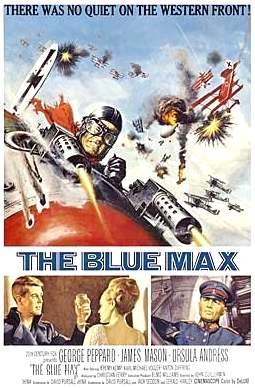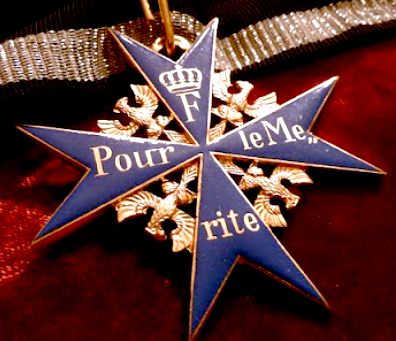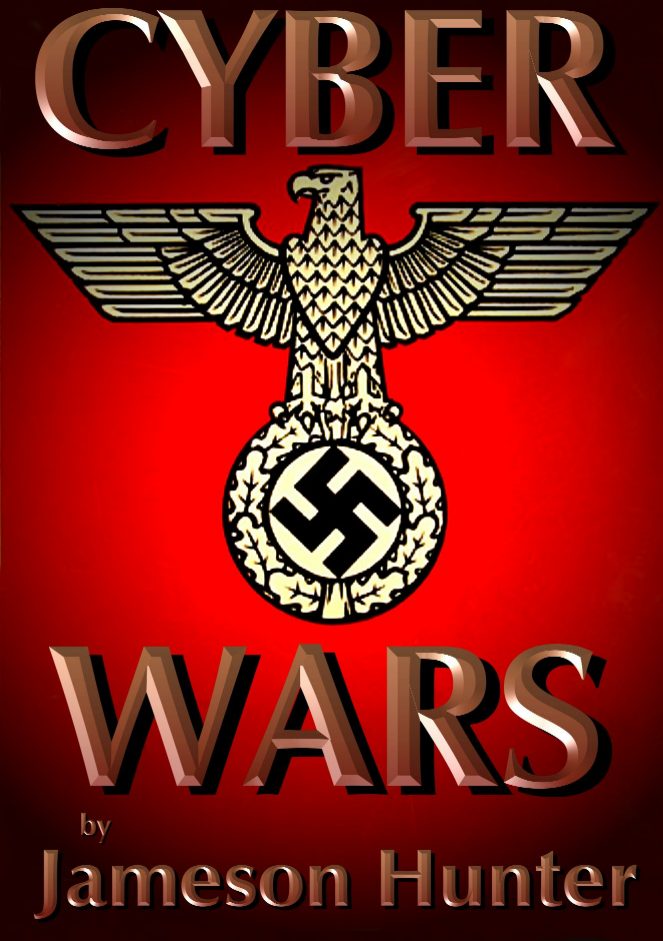|
The
Blue Max is a 1966 United
Kingdom World
War I film, directed by John Guillermin, filmed in Ireland, starring
George Peppard, James Mason, Ursula Andress and Jeremy Kemp. The
screenplay was written by David Pursall, Jack Seddon and Gerald Hanley,
based on the novel by Jack Hunter.

Plot
Lieutenant
Stachel (Peppard), an ambitious pilot who transferred to the German
Air Service from the trenches, is trying to win the coveted military
decoration, the Pour
le Mérite, better known as the Blue
Max, for which he must shoot down twenty enemy aircraft. He will
stop at nothing in his quest. First he must overcome the disdain of his
fellow pilots, but ultimately fails because he puts them at risk for his
own purposes. His commanding general, von Klugermann (James Mason), sees
the propaganda value of this junior officer for the 'common people'
because he is one of them. When he meets the Red
Baron in mid air and helps him escape from UK airplanes, he is shot
down himself. Because this disables him from flying, von Klugermann uses
the opportunity to order him to Berlin for propaganda purposes, where he
gets to see a new mono-winged prototype. Later, he is ordered to air-test
this new airplane, which considered to be too dangerous to fly in an
earlier testflight, to send him to his death because his ambitious lies
endangered the integrity of the military corps.
Features
The
film follows the story in the book of the same title by Jack Hunter, but
deviates significantly in its portrayal of the characters. The plot of the
film focuses on the role of propaganda and the exploitation of the pilots,
particularly Stachel, who is enticed by the glamour of the Pour le
Merite. The character of Leutnant von Kluegemann (Jeremy Kemp) is more
gentle and played with a touch of gallantry in the film, in contrast to
what one reads in the novel.
The
planes used in the film were converted Tiger Moths. Two aircraft were
given extra attention to more closely resemble the German Pfalz III and
Fokker VII, flown by the main actors. In particular the work on the Pfalz
III , the first plane flown by Stachel, is unique. One may observe however
that in the beginning of the film the lower wings were not painted until
later. The 'Lozengze' German camouflage at the time was not so generalised
to all units but in the film all of them are kept under this scheme.
The
Fokker DR I triplanes are purpose-built replicas. The Tiger Moth
silhouette was more appropriate to British aircraft of the period, and
present a good general impression of actual contemporary aircraft.
This
film is particularly well regarded in its depictions of aerial combat.
Stunt
flying
One
of the stunt pilots used in the film was Derek Piggott. Several pilots
helped recreate the live dog-fights scenes for the film, but Piggott was
the only pilot to agree to fly the stunt at the climax of the film in
which the two rivals challenge each other to fly beneath the spans of a
bridge. Taking the role of both German pilots and with multiple takes from
contrasting camera angles, he ended up flying through the wide span of
this bridge in Fermoy Co. Cork Ireland
15 times and 17 times through the narrower span. The two Fokker Dr.I
triplane replicas had about four feet of clearance on each side when
passing through the narrower span. The director had placed a flock of
sheep next to the bridge so that they would scatter as the plane
approached in order to demonstrate that the stunt was real and had not
used models. However, by later takes, the sheep had become accustomed to
the planes and continued to graze, creating a continuity error which can
be seen in the finished film. The sheep had to be scared by the shepherd
instead. He was able to fly through the arch reliably by aligning two
scaffolding poles, one in the river and one on the far bank.
Blue
Max Badges
Each
of the principal people on the movie, the producers, the director, the
writers and actors etc, were given a replica copy of the Blue Max badge,
made in silver and smaller than the original badge.
The
French Village
The
scenes where the Germans come into the French village were filmed on
Calary Bog in County Wicklow in Ireland. For many weeks the building of
the village attracted the locals to watch it coming up. Then it was bombed
and made to look destroyed. It was a local tourist attraction for a long
time after the film had wrapped.
Berlin
The
Scenes supposed to be in Berlin were shot in Dublin. Christchurch
Cathedral is easily recognisable in the background of many scenes and
Trinity College served as the army headquarters where Von Klugerman's
office is located.
Quote
When
general von Klugermann, who wants Stachel to figure as a hero for the
common people, asks about the condition of Stachel when he wants to get
him to Berlin, and hears that he has been shot in the arm, he says
"Good, the people like soldiers to be shot in the right places".
John Guillermin
Jack Hunter (novel)
Ben Barzman (adaptation)
...
Genre:
Adventure / Drama
/ War / Action
Tagline: The raiding squadrons of the Red Baron..
Plot Outline: A young pilot in the German air force of
1918, disliked as lower-class and unchivalrous, tries ambitiously to earn
the medal offered for 20 kills.
User Comments: Excellent Aerial Photography Highlights
WWI Adventure
User Rating: *******
6.8/10 (1,015 votes)
User
Comment
Unmistakably
one of the most entertaining war films to come out of the 1960s, "The
Blue Max" is the kind of film that could only have been made in
Hollywood. Featuring some of the best aerial combat scenes ever shot and a
great ensemble cast, it's enjoyable pulp fantasy for any war film fan.
The film opens with a brilliant, intense action sequence: Bruno Stachel
(George Peppard, "Tobruk") dives into a mud-filled crater on the
Western Front. He's visibly exhausted; his heavy breathing and unshaven
face reveal how horrible front line conditions are. From above comes the
sound of a dogfight – Peppard's bright blue eyes blare from a
mud-covered face as he stares in awe at the action in the skies above him,
the mood fully established with Jerry Goldsmith's evocative score. Flash
forward two years: Stachel has transferred to the Luftwaffe and is a
green, inexperienced pilot. A peasant, Stachel has little in common with
his high-class comrades, members of the elite Officer Corps. He's ruthless
and ambitious, and sets his sight on winning a Blue Max – the medal
awarded to a pilot with 20 kills to his credit. With this award, Bruno
will have won the respect of his comrades. Squadron commander Heidemann
(Karl Michael Vogler, "Patton") has one, and hotshot Willi von
Klugermann (Jeremy Kemp, "Operation Crossbow") is awarded one
early in the film. Stachel vigorously has to catch up to their status, and
Willi takes a liking to him, helping him try to fit in.
As Germany is losing the war, Willi's uncle, General von Klugermann (James
Mason, "Cross of Iron") enters the stage: he sees potential in
Stachel for more than just flying prowess. This is a time when the common
people of Germany need a hero. Stachel is a poor farm boy, someone they
can all relate to. Von Klugermann sets out to make Stachel a national
icon; when he received a minor wound, he's escorted to a cushy Berlin
hotel and the press takes pictures of a nurse tending to his wound,
plastering pictures all over the national newspapers. Countess Kaeti von
Klugermann (the beautiful Ursula Andress) sets her sights on Stachel, and
soon a steamy affair has begun, right under the nose of the General. As
Stachel's selfish ambitions become more apparent and blatant, Willi's
friendly competitiveness fades and their adversity becomes an all-out
battle. All of this builds to an unavoidable, somewhat depressing ending.
This is a character-driven drama firstly, and the action is simply a
supplement to the story of the characters. Unfortunately, Peppard is a
wooden lead. He speaks in unaccented English and never seems to be
thoroughly involved in his part; it's as though he's sleepwalking through
almost every scene. The rest of the cast deserves more credit. Co-star
Jeremy Kemp is much more believable. He's sly, cynical and delivers
fantastic deadpan humor. James Mason is brilliant as usual as General von
Klugermann, a career German officer whose chief concern is for the German
people and his nation's prestige. I have never seen Mason deliver a bad
performance, and here he is simply fantastic. He's often cool and
restrained, but lets anger and rage come out full-force at key moments. As
his unfaithful wife, Ursula Andress is her typical self; beautiful and
often barely concealed. A standout is Karl Michael Vogler as Heidemann. A
veteran flyer devoted to his duty, Heidemann is a career soldier. He's
been fighting since the beginning of the war, and although weary and
tired, keeps doing his job. His chief goals are keeping as many planes
flying as possible, despite Allied air attacks and supply shortages. He
demands that Stachel's ambitions take second fiddle to strategic
operations; when he disobeys orders, Heidemann threatens to have him
court-martialed. Vogler's performance is excellent, and he walks away with
each of his scenes.
Director John Guillermin and Director-of-Photography Douglas Slocombe
weave some excellent flying sequences into the film's story. These action
scenes are not independent conflicts between German and English fighters
– conflicts between characters are developed on the ground and either
expanded or settled in the air. The skies have never been bluer, and the
vintage aircraft look fantastic as they dive, swoop and strafe enemy
columns. The stunt work and special effects are genuine, even some
brilliantly-staged crash sequences. Even the work of Guy Hamilton and crew
in 1969's "Battle of Britain" pales in comparison to this. The
scenes of trench warfare and bombing runs are massive and spectacular. The
mud-splattered soldiers, vast fields dotted with rotting corpses and bomb
craters, and some hand-to-hand combat has never looked more authentic.
Every cent invested in the film was put to good use. Scenes in Berlin –
particularly that in the hospital and food riots shot through a moving car
window – are historically accurate.
Guillermin isn't afraid to experiment with camera during the discussion
scenes. Note how he often places two actors in one room on opposite ends
of the frame, simply to capture the scope of the interiors. Marvelous pans
show off huge numbers of extras and planes taking off and landing. There's
also a long crane shot showing a huge, lavish dining hall at the Von
Klugermann's mansion which captures the essence of nobility and
aristocracy in one shot.
"The Blue Max" is a brilliantly shot, engaging and wildly
entertaining World War I epic which should satisfy any fan of aircraft and
war films. This is a must-see DVD, which preserves the CinemaScope ratio
(a necessary asset, as pan-and-scan versions detract from the epic look of
the picture) and also features a great restored surround-sound track and
stunning digital image quality. It's the only acceptable way to see this
film in the modern world.

Runtime: 156 min / USA:153 min (FMC Library Print)
Country: UK
Language: English
Color: Color
(DeLuxe)
Sound Mix: 4-Track
Stereo (magnetic prints) / Mono
(optical prints)
Certification: Canada:G
(Quebec) / Australia:PG
/ Finland:K-16
/ Sweden:15
/ UK:PG
/ USA:Unrated
/ West
Germany:12 / Singapore:NC-16
/ Iceland:12
Trivia: In some scenes George
Peppard was actually flying his plane.
Goofs: Factual errors: The German soldiers were using
the British SMLE (Short Magazine Lee Enfield) throughout the movie. The
correct German rifle should be the Mauser. Mauser rifles do not have a
visible magazine, whereas the Enfield does. (more)
Quotes:
General Count von Klugermann: Stachel. I want him brought to Berlin
immediately.
Aide: Yes, Herr General.
General Count von Klugermann: There is some difficulty?
Aide: Well, I don't know what you have in mind, Herr General, but,
uh, with the offensive at its height, well, there'd have to be some
legitimate excuse to order him to come.
General Count von Klugermann: He's wounded, isn't he?
Aide: Yes, Herr General.
General Count von Klugermann: Hmm. A mentionable wound?
Aide: Uh, in the arm.
General Count von Klugermann: Good. The people like soldiers who
were shot in the right places. Order Stachel to Berlin for special
hospital treatment. I want you to ensure that all our newspapers give full
prominence to this gallant episode -- photographs, everything.
Awards: Won BAFTA Film Award. Another 4 nominations
LINKS

Stirrings
in the Amazon jungle send alarm bells ringing for John Storm and his
intrepid crew.
|

